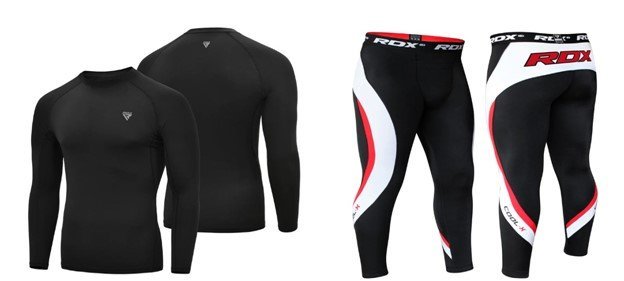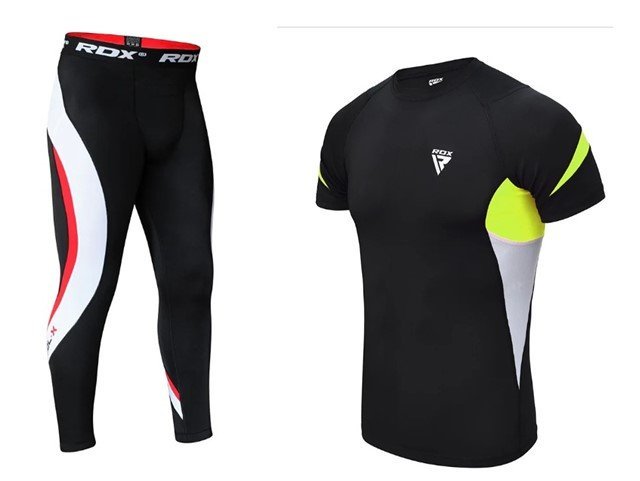Unlock Performance and Recovery with Premium Compression Wear

Compression wear has become a buzzword in the world of fitness and athletics. But what precisely is it, and what makes it so popular? Compression wear refers to clothing designed to provide support and enhance performance through graduated compression. This snug-fitting attire has been embraced not just by athletes but also by individuals seeking better recovery and injury prevention. Let's dive deeper into the world of compression wear, exploring its benefits, types, and much more.
Types of Compression Wear:
Compression wear comes in various forms, each catering to different needs and parts of the body.
Compression Socks:
Compression socks are probably the most recognized type of compression wear. They cover the foot and calf, providing graduated pressure that helps improves blood circulation and reduces swelling.
Compression Sleeves:
These are typically used for the arms or calves. They are great for providing targeted support and are popular among runners and basketball players.
Compression Shorts and Tights:
These garments are designed to support the thighs and lower body. They are commonly used in sports like cycling, running, and weightlifting to improve muscle support and reduce fatigue.
Full-Body Compression Suits:
For full-body support, there are compression suits. These are used primarily by professional athletes who need comprehensive muscle support and improved circulation during intense training and competition.
Benefits of Compression Wear:
The popularity of compression wear isn't just a fad; there are several science-backed benefits to wearing these garments.
Improved Blood Circulation:
One of the primary benefits of compression wear is improved blood circulation. The graduated pressure helps blood flow more efficiently back to the heart, reducing the risk of blood pooling in the limbs.
Enhanced Performance:
Athletes often use compression wear to boost their performance. The support to muscles and joints can lead to better stability and reduced muscle oscillation, allowing for more efficient movement.
Reduced Muscle Soreness:
Wearing compression gear during and after workouts can significantly reduce muscle soreness. This is particularly beneficial for those engaging in high-intensity or endurance sports.
Injury Prevention:
By providing added support to muscles and joints, compression wear can help prevent injuries. This is particularly important for athletes who are constantly pushing their bodies to the limit.
Scientific Research on Compression Wear:
There has been extensive research into the effectiveness of compression wear, with many studies highlighting its benefits.
Studies on Athletic Performance:
Research has shown that athletes wearing compression gear often report improved performance, particularly in sports requiring endurance and strength.
Studies on Recovery:
Compression wear has been found to aid in quicker recovery post-exercise. The improved circulation and support help reduce the time it takes for muscles to heal and regain strength.
Studies on Injury Prevention:
Many studies have also highlighted the role of compression wear in preventing injuries, especially in high-impact sports. The added support to muscles and joints can significantly lower the risk of strains and sprains.
How Compression Wear Works:
Understanding how compression wear works can help you make the most of its benefits.
The Science of Compression:
Compression wear applies graduated pressure to specific areas of the body. This pressure helps improve blood flow, reduce muscle vibration, and support the body's natural movements.

Compression Levels and Their Effects:
Compression garments come in different levels of pressure, measured in millimetres of mercury (mmHg). The level of compression you need depends on your activity and specific requirements.
Materials Used in Compression Wear:
High-quality compression wear is typically made from materials like spandex, nylon, and polyester. These materials offer elasticity, durability, and moisture-wicking properties.
Who Should Use Compression Wear?
Compression wear isn't just for athletes. It can be beneficial for a wide range of individuals.
Athletes:
Athletes are the primary users of compression wear. Whether they are running, cycling, or playing team sports, compression gear helps enhance their performance and speed up recovery.
Non-Athletes:
Even if you're not an athlete, compression wear can be beneficial. People who stand for long periods, like nurses and retail workers, can use compression socks to reduce leg fatigue and swelling.
People with Medical Conditions:
Compression wear is also recommended for individuals with certain medical conditions, such as varicose veins, lymphedema, and deep vein thrombosis. It helps improve circulation and manage symptoms.
Choosing the Right Compression Wear:
With so many options available, choosing the right compression wear can be daunting.
Factors to Consider:
When selecting compression wear, consider the type of activity, the level of compression needed, and the specific area you want to target.
How to Measure for Compression Wear:
Ensuring a proper fit is essential for the effectiveness of compression wear. Measurements should be taken at specific points on the body to ensure the right level of compression.
Popular Brands and Products:
Some popular brands offering high-quality compression wear include 2XU, CEP, and Skins. These brands are known for their durable and effective products.
Compression Wear in Different Sports:
Different sports have specific requirements when it comes to compression wear.
Running:
Runners benefit from compression socks and shorts that improve blood flow and reduce muscle fatigue.
Cycling:
Cyclists often wear compression tights and sleeves to enhance performance and reduce soreness during long rides.
Basketball:
Basketball players use compression sleeves and shorts for better support and injury prevention.
Soccer:
Soccer players wear compression socks and sleeves to improve stamina and protect against injuries.
Gym Workouts:
In the gym, compression shirts and shorts help support muscles during intense weightlifting sessions.
Compression Wear for Recovery:
Compression wear isn't just for during exercise; it's also highly beneficial for recovery.
Post-Workout Recovery:
Wearing compression gear after a workout can help reduce muscle soreness and speed up recovery time.
Post-Surgery Recovery:
Compression wear is often recommended post-surgery to improve blood circulation and reduce swelling.
Managing Chronic Conditions:
For those with chronic conditions like lymphedema, compression wear is a daily necessity to manage symptoms and improve quality of life.
Potential Drawbacks of Compression Wear:
While compression wear offers many benefits, there are some potential drawbacks to consider.
Possible Discomfort:
Some people may find compression wear uncomfortable, especially if it's too tight or worn for extended periods.
Skin Issues:
Wearing compression gear can sometimes cause skin irritation or rashes, particularly if the material is not breathable.
Over-Reliance on Compression Gear:
Relying too much on compression wear can lead to weakened muscles and joints if not used in conjunction with proper training and recovery techniques.
Care and Maintenance of Compression Wear:
To ensure your compression wear lasts and remains effective, proper care is essential.
Washing and Drying Tips:
Always adhere to the manufacturer’s guidelines for washing and drying. Generally, hand washing and air drying are recommended to maintain elasticity.
Storage Recommendations:
Store your compression wear in a cool, dry place to prevent damage to the fabric and maintain its compression properties.
When to Replace Compression Wear:
Compression wear should be replaced when it loses its elasticity or starts to show signs of wear and tear.
Innovations in Compression Wear:
The world of compression wear is continually evolving with new innovations.
Smart Compression Wear:
Some compression garments now come with integrated sensors that track performance and recovery metrics.
Conclusion:
Compression wear has revolutionized the way athletes and everyday individuals approach physical activity and recovery. By offering improved blood circulation, enhanced performance, reduced muscle soreness, and injury prevention, compression garments have become an essential part of modern fitness routines. The science behind compression wear supports its benefits, making it a valuable addition to both athletic and medical wardrobes.
What's Your Reaction?











![Wireless Connectivity Software Market Size, Share | Statistics [2032]](https://handyclassified.com/uploads/images/202404/image_100x75_661f3be896033.jpg)




